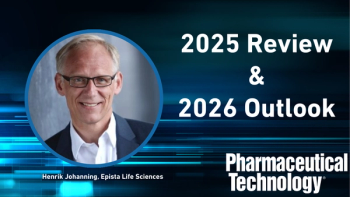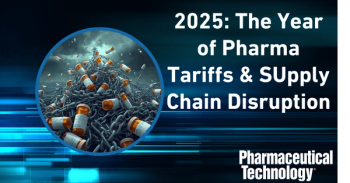
- Pharmaceutical Technology-09-02-2008
- Volume 32
- Issue 9
The Potential of Continuous Sterile Manufacturing
Sterile manufacturing may be the next aspect of pharmaceutical manufacturing to consider in the continuous process paradigm.
Much of the attention given to continuous processing has centered on soliddosage and small-molecule manufacturing. Similar advantages of reduced process variability and potentially lower manufacturing costs, however, may be achieved with continuous sterile manufacturing. Pharmaceutical Technology Senior Editor Patricia Van Arnum discusses the potential of continuous sterile manufacturing with Fred Watson, executive vice-president and cofounder of Neovex (Northbrook, IL), a provider of technology and equipment for continuous sterile processing for pharmaceutical production.
PharmTech: When was Neovex founded, what are your core competencies, and when and why did the company begin offering continuous processing systems for sterile manufacturing?
Watson: Neovex was founded in 1993 with the specific purpose of designing and fabricating fully integrated intravenous (IV) and renal solutions production systems scaled to meet local or regional demand. The company designs and integrates all the subsystems necessary to produce IV and renal solutions: water-for-injection (WFI) production, blending, packaging, and terminal sterilization. In part, the genesis of Neovex was Baxter Healthcare's desire to mate a continuous solution production system with the continuous form–fill–seal system that it had developed. One of Baxter's goals was to set up distributed solutions manufacturing. Much like the beer industry's move from centralized to regional brewing to reduced transportation expense, Baxter did a strategic assessment of manufacturing technologies to produce IV solutions regionally. Although Baxter never moved beyond small-scale production prototypes, Neovex enhanced the basic concept by incorporating continuous production techniques and technology in common use in the petrochemical industry and applied them to the pharmaceutical industry.
As with other technology-based companies, Neovex's core competencies are derived from professionals that founded the company and the talent pool available to it in northern Illinois, corporate home to Baxter, Abbott Laboratories, G.D. Searle [now part of Pfizer], and others. Continuous production design and engineering knowledge initially came from engineers that had worked for the leading automated pilot-plant company in the US. They were particularly knowledgeable in state-of-the-art continuous process manufacturing and control technologies across a broad range of industries: refining, chemicals, and petrochemicals. Neovex complemented their engineering skills with expertise in pharmaceutical sterilization techniques and procedures, operational pharmaceutical quality assurance/quality control (QA/QC), and regulatory experience with the US Food and Drug Administration. Additionally, Neovex has drawn on the expertise of its technology vendors in in-line measurement, instrumentation testing, and computer process control. Neovex has also attracted design and project management talent from leading pharmaceutical engineering consulting and engineering firms.
Admittedly, Neovex was ahead of its time with regard to offering a continuous IV production system. The advantages and technology for safely producing IV solutions have been available for more than 15 years. The greatest barriers to adopting the economic and quality benefits of continuous process technologies in the pharmaceutical industry have been the innate conservatism of the pharmaceutical industry and FDA along with a high degree of comfort with batch processing. That said, the benefits of continuous production technology are very compelling. Batch protocols don't guarantee quality. Quality is 'tested into' batch products. You know they are good only after laboratory testing. In contrast, quality is 'designed into' continuous systems. They can be designed with 'fail-safe' processes that do not allow the production of off-spec product. If the solution doesn't meet specifications at each and every step, it can move no further in the process. Continuous production eliminates human contact and contact with the surrounding work environment.
In addition, automated continuous production can increase a facility's output by 100–400% while reducing its footprint and cutting all costs, including capital-equipment costs, facility costs (including cleanroom costs), and out-of-pocket costs for labor, laboratory analysis, maintenance, and utilities.
PharmTech: Can you explain how systems for continuous processing for in-blending and WFI operate and how these differ from what is typically performed in a batch environment?
Watson: Continuous production can be achieved with a number of different process designs. There is not one best design. A continuous system can be designed to be highly flexible to accommodate multiple products or to be very specialized to produce a single product at the absolute lowest cost. They can be designed to use liquid or powdered ingredients or a combination.
An essential difference between continuous and batch production is the elimination of WFI, product blending, and product storage tanks. All production occurs in-line in 'tubes.' WFI is produced continuously as needed (with one of several methods), not stored in a WFI storage tank. Monitored, purified sterile ingredients or ingredient blends are injected into the WFI stream under precise, predictive computer control with constant multipoint redundant measurement and computer analysis. Even the slightest variation in product specification is immediately adjusted to prevent the product from ever being out of spec. In the unlikely event that the system cannot maintain specifications, production stops immediately. After blending, product is then ready for immediate packaging or use in a subsequent production step. Continuous systems easily allow aseptic production, the 'technical' elimination of terminal sterilization and parametric release, all of which contribute to cost savings.
A continuous WFI and blending unit generally has a footprint less than onefourth that of a batch unit and often uses less than one-eighth the volume of a comparable batch unit.
PharmTech: What are the challenges in adapting sterile manufacturing to a continuous processing environment? Are there certain functions that lend themselves better to continuous as opposed to batch manufacturing? Under what conditions or situations is continuous processing most appropriate?
Watson: Sterile manufacturing is actually far easier in a continuous system than in a batch system. In a continuous system, product production is totally isolated from the surrounding environment and production staff. From a technical standpoint, no cleanrooms are needed because once nonsterile ingredients enter the system, they are sterilized and then never exposed to the surrounding environment or human contact.
In many traditional batch systems, contaminants are introduced by even pharmaceutical–grade ingredients. Those contaminants are tolerated through production and then removed by a pharmaceutical-grade filter. But that filter can fail, letting contaminants through. Sampling and laboratory analysis are used to identify those failures.
In continuous production, contaminants are removed early in the process by methods that fail by blocking the flow of solution, not by letting particulates through. Once established, the conditions needed for sterile continuous production can be maintained indefinitely, for days, weeks, even months.
In the US, the biggest current challenge to adopting sterile continuous process technology is the barrier of approving 'Unit One.' 'Unit One' is the risk or being first or doing something for the first time. The risk of 'Unit One' in the context of continuous process production in the pharmaceutical industry is not engineering. Virtually all engineering and equipment used in the Neovex continuous system have been tested and proven in daily use in a myriad of related industrial applications. The risk of 'Unit One' is regulatory—the FDA, the great unknown. Leading that charge will mean the investment of capital, manpower, and time to work with the FDA. And from a purely competitive point of view, it is difficult for one pharmaceutical company to justify knocking down regulatory barriers for the benefit of the industry.
When we assess market opportunities for the first continuous process unit, we look at two principal factors as outlined below:
- Simple product: While continuous technology can be applied to a variety of products, we look at products that are technically 'simple' such as large-volume parenterals [normal saline, dextrose (5%), peritoneal dialysis solutions, or buffers for biotech production].
- Large volume, long production runs: While continuous systems can excel at rapid, automated switching between small batches, large volumes allow us to displace massive, costly batch tanks with small, compact continuous blending units. The result? Less of everything—real estate, facility, capital investment, staff, and utilities. Start it up and let it run, 24 x 7 x 365.
PharmTech: On an industry-wide basis, do you foresee a possible evolution from batch manufacturing to continuous processing, and if so, to what extent, in what manner, and along what timeframe do you think this may occur?
Watson: Continuous processing technology has been available and practical for more than a decade, but it has yet to be embraced by a pharmaceutical manufacturer. Neovex is still in the exploratory stages of applying continuous process technology in the pharmaceutical and biotech industries in the US. A both good and bad attribute of the pharmaceutical industry is that it is very slow to change accepted manufacturing practices. Ongoing assessment of continuous production at a few large pharma companies is an encouraging sign. Positive assessment of the technology and QA/QC validation techniques will likely lead to nonoperational, pilot-plant test platforms.
For pharmaceutical companies, the major challenges to acceptance of continuous processing will be developing internal comfort with a new approach, lack of financial necessity, and getting FDA agreement to and codification of quality validation standards. Hopefully, the process analytical technology (PAT) initiative will address and resolve these issues. The hurdle for continuous process technology in the pharmaceutical industry is mainly emotional and regulatory, not technological. The equipment and technology to support continuous production is available and operationally validated. The pharmaceutical industry could implement continuous production techniques right now.
Our experience to date shows that the biotech portion of the pharmaceutical industry will be the first to embrace continuous production. The serious diseconomies of scale of large batch biotech production are driving the cost of production facilities into the stratosphere. Also, the technological and design challenges of ever-larger batch systems are becoming acute and expensive to resolve. As biotech engineers come to understand the dramatic facility, capital, and production cost savings of continuous production, they will start to embrace the technology.
PharmTech: What do you see as the key regulatory/compliance issues in moving from batch to continuous processing? In what ways, if any, is the FDA or other regulatory authorities facilitating the evaluation or move to continuous processing (such as through the PAT initiative)?
Watson: Both US and European regulators are starting to understand the significant quality and safety benefits of continuous production. They are beginning to come to grips with 'fail-safe' design and starting to explore alternative testing, process control and validation methods. Something as simple as the concept of a 'batch' sheds light on the scope of the changes that will be made. All our validation processes revolve around the 'batch.' In continuous production, there really is no batch, no start or end. Any definition of batch size is arbitrary and part of a transition from batch thinking to continuous thinking. The PAT initiative, however, is an excellent start down that path.
For more information on continuous processing, see "
Articles in this issue
over 17 years ago
A Catalyst for Environmental Consciousnessover 17 years ago
Chiral Separationsover 17 years ago
Report From: Indiaover 17 years ago
Pharma Capsulesover 17 years ago
Make Yourself Countover 17 years ago
Sustainability Surprisesover 17 years ago
Drug Imports under Scrutinyover 17 years ago
Global Warming Heats Up Need for Malaria VaccineNewsletter
Get the essential updates shaping the future of pharma manufacturing and compliance—subscribe today to Pharmaceutical Technology and never miss a breakthrough.




